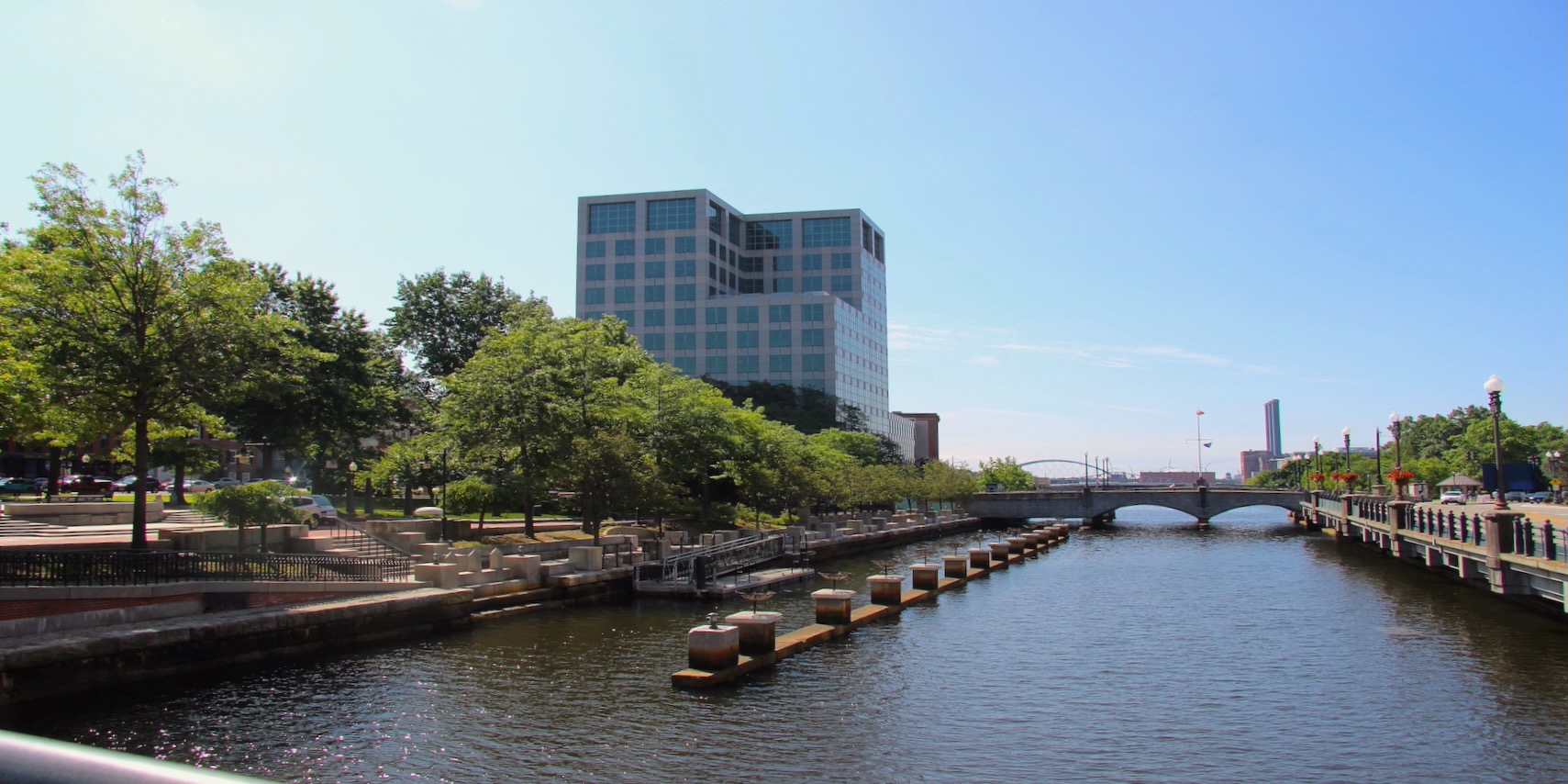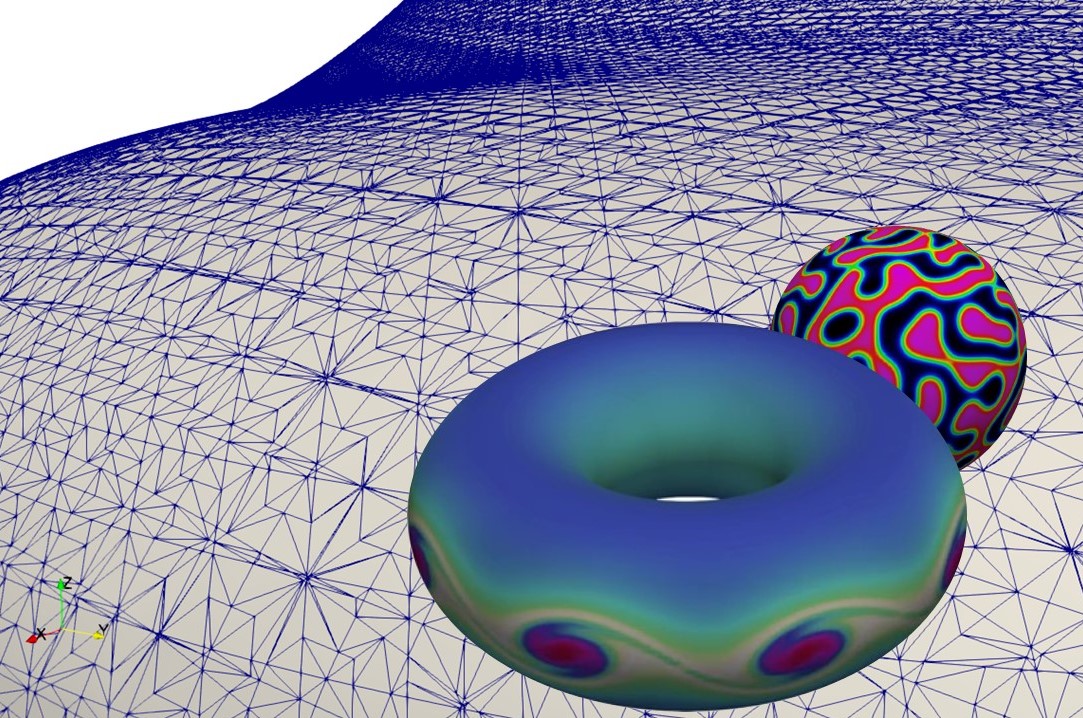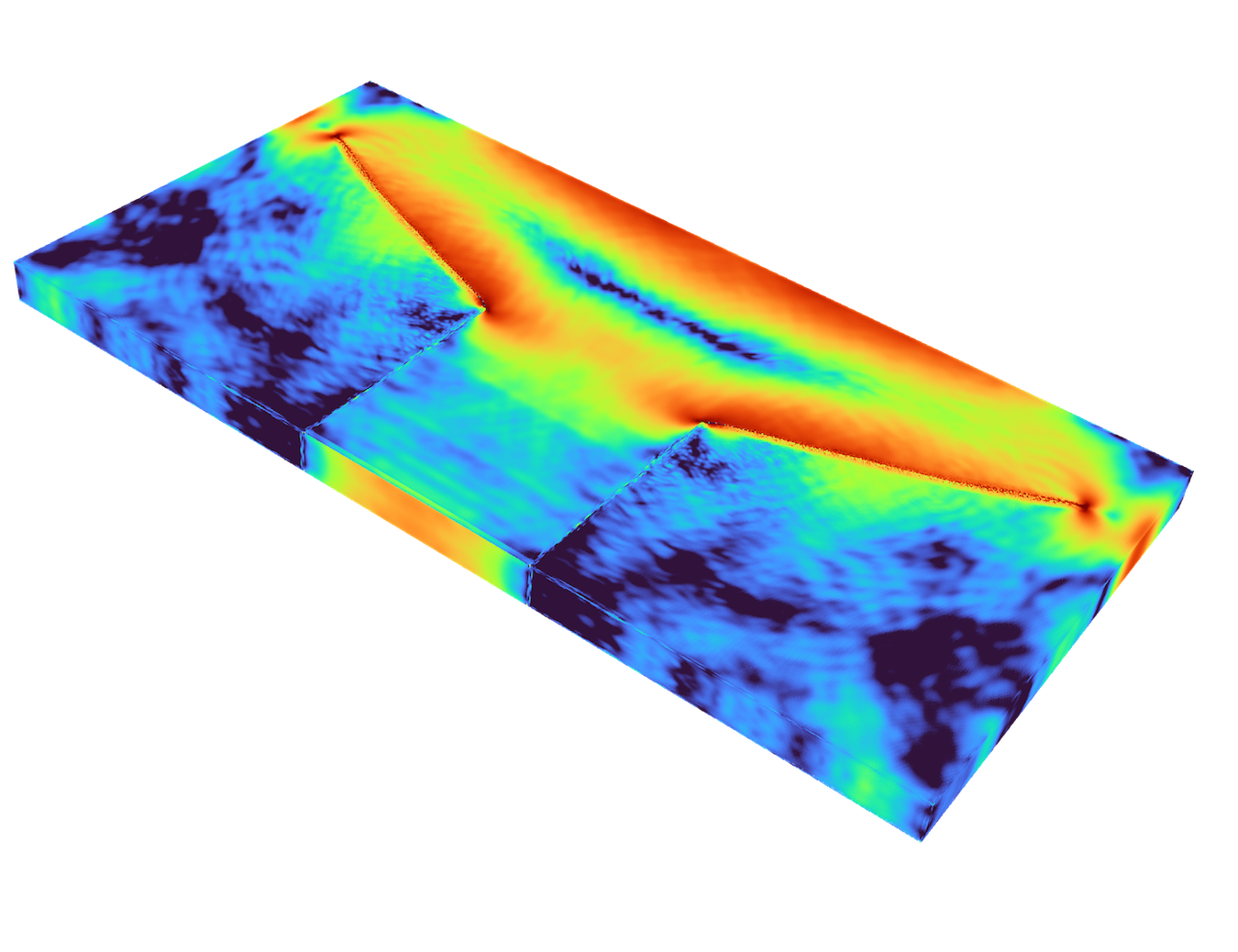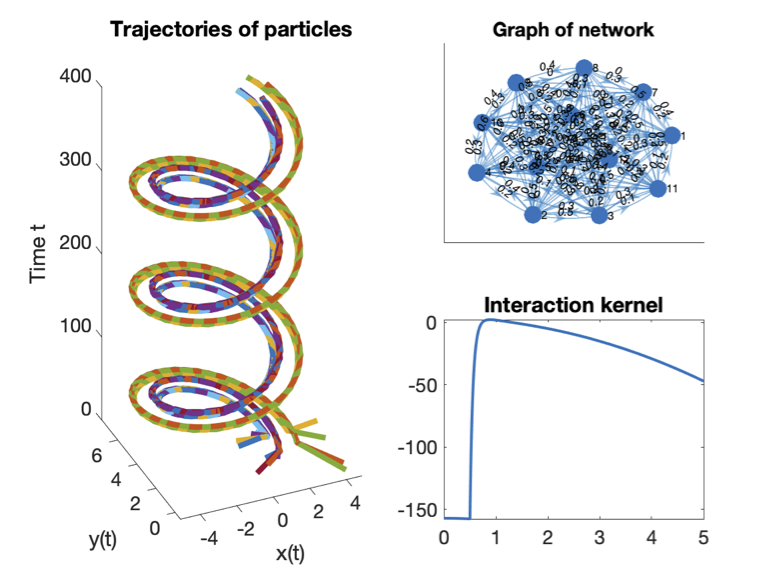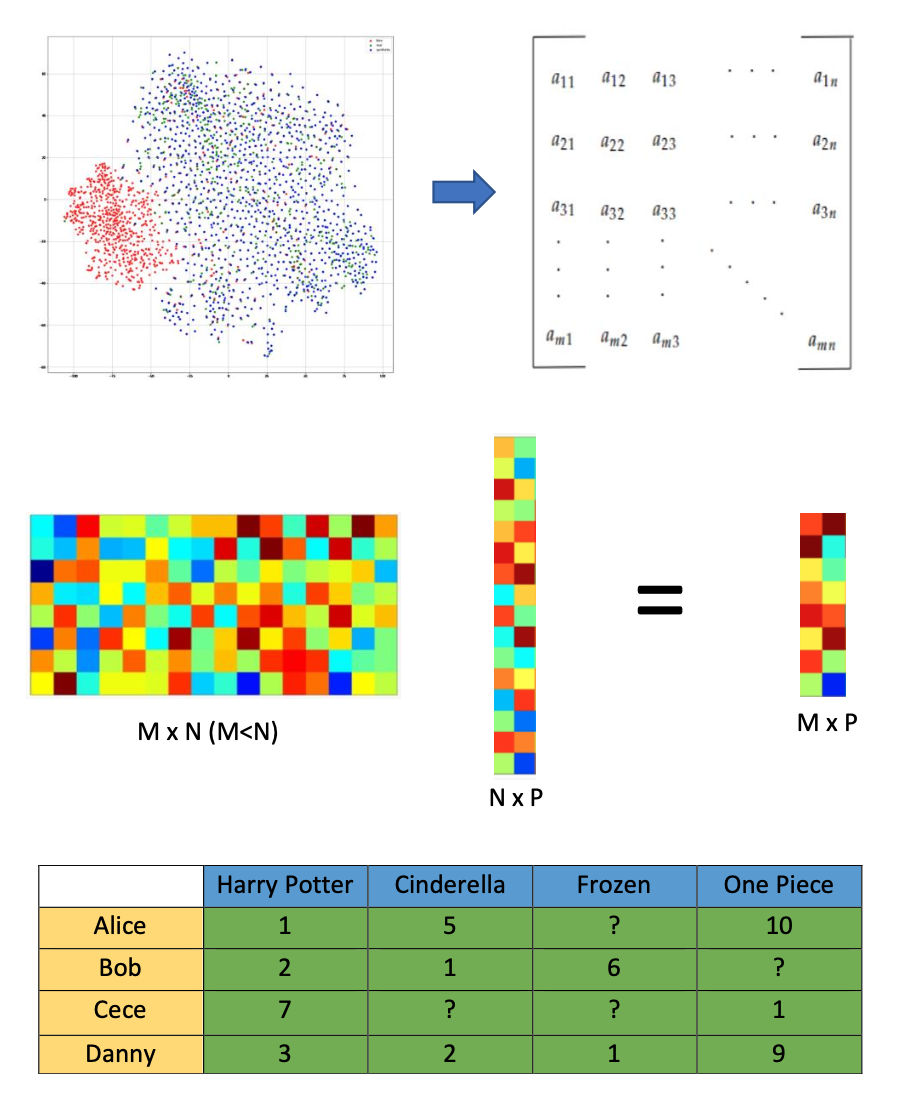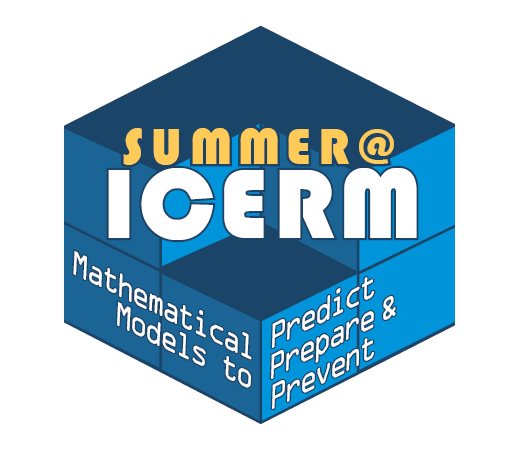This Week at ICERM
Your device timezone is . Do you want to view schedules in or choose a custom timezone?
April 14, 2024
There are no events currently scheduled for April 14th.
April 15, 2024
-
8:30 - 8:50 am EDTCheck In11th Floor Collaborative Space
-
8:50 - 9:00 am EDTWelcome11th Floor Lecture Hall
-
9:00 - 10:20 am EDTAn invitation to nonlocal modelsTutorial - 11th Floor Lecture Hall
- Speaker
- Xiaochuan Tian, University of California-San Diego
- Session Chair
- Abner Salgado, University of Tennessee
Abstract
There has been a growing interest in studying nonlocal models as more general and sometimes more realistic alternatives to conventional PDE models. In this tutorial, we will introduce nonlocal models. In particular, we will focus on the nonlocal models with a finite range of nonlocal interactions, which connect the classical PDEs, nonlocal discrete models, and fractional differential equations. This talk will cover nonlocal modeling, nonlocal vector calculus, and numerical analysis for the nonlocal models.
-
10:30 - 11:00 am EDTCoffee Break11th Floor Collaborative Space
-
11:00 am - 12:20 pm EDTTutorial on fractional calculusTutorial - 11th Floor Lecture Hall
- Speaker
- Abner Salgado, University of Tennessee
- Session Chair
- Pablo Seleson, Oak Ridge National Laboratory (ORNL)
Abstract
We will discuss several approaches to extend the notion of a derivative to a fractional order, their meaning, limitations, and possible applications. For some of these, we will study the existence, uniqueness, and regularity of solutions to initial boundary value problems with these operators, and their implications for numerical approximations
-
12:30 - 2:00 pm EDTLunch/Free Time
-
2:00 - 3:20 pm EDTTutorial on peridynamicsTutorial - 11th Floor Lecture Hall
- Speaker
- Pablo Seleson, Oak Ridge National Laboratory (ORNL)
- Session Chair
- Xiaochuan Tian, University of California-San Diego
Abstract
Peridynamics is a powerful nonlocal reformulation of classical continuum mechanics, suitable for material failure and damage simulation, which has become very popular in recent years. In contrast to classical constitutive relations that employ spatial differential operators, peridynamic models use spatial integral operators which do not require spatial differentiability assumptions of displacement fields. This enables a natural representation of material discontinuities such as cracks. Peridynamic models possess length scales, making them also suitable for multiscale modeling. This tutorial will provide an overview of peridynamics, including some of its mathematical, computational, and modeling aspects.
-
3:30 - 4:00 pm EDTCoffee Break11th Floor Collaborative Space
-
4:00 - 4:45 pm EDTAnalytical and applied aspects for nonlocal curvature11th Floor Lecture Hall
- Speaker
- Petronela Radu, University of Nebraska, Lincoln
- Session Chair
- Xiaochuan Tian, University of California-San Diego
Abstract
Curvature is a fundamental concept in physics and it plays a crucial role in various areas such as: classical mechanics, general relativity, optics, and fluid dynamics. In particular, the curvature of surfaces can affect the mechanical, electrical, and optical properties of materials, so curvature effects need to be taken into account when designing and analyzing new materials. The recently introduced concept of nonlocal curvatures provide a frameworks for measuring the “bend” of a surface under little or no smoothness assumptions, while connecting to classical curvature as the horizon of interaction converges to zero. In this talk I will focus on two distinct problems: of constant nonlocal curvature and of ordered curvature and show how they relate to their classical counterparts.
-
5:00 - 6:30 pm EDTReception11th Floor Collaborative Space
April 16, 2024
-
9:00 - 9:45 am EDTQuasi-linear fractional operators in Lipschitz domains: regularity and approximation11th Floor Lecture Hall
- Speaker
- Ricardo Nochetto, University of Maryland
- Session Chair
- Abner Salgado, University of Tennessee
Abstract
Fractional diffusion in bounded domains is notorious for the lack of boundary regularity of solutions regardless of the smoothness of domain boundary. We explore this matter for the homogeneous Dirichlet problem for fractional-order quasi-linear operators with variable coefficients in Lipschitz domains and any dimensions; this includes fractional p-Laplacians and operators with finite horizon. We prove lift theorems in Besov norms which are consistent with the boundary behavior of solutions in smooth domains. The proof exploits the underlying variational structure and uses a new and flexible local translation operator. We further apply these regularity estimates to derive novel error estimates for finite element approximations of fractional p-Laplacians and present several simulations that reveal the boundary behavior of solutions.
-
10:00 - 10:30 am EDTCoffee Break11th Floor Collaborative Space
-
10:30 - 11:15 am EDTThe role of fractional diffusion in the optimal recovery of partial differential equations without boundary conditions11th Floor Lecture Hall
- Speaker
- Andrea Bonito, Texas A&M University
- Session Chair
- Abner Salgado, University of Tennessee
Abstract
The problem of learning an unknown function from given data, i.e., construct an approximation to the function that predicts its values away from the data is ubiquitous in modern science. There are numerous settings for this learning problem depending on what additional information is provided about the unknown function, how the accuracy is measured, what is known about the data and data sites, and whether the data observations are polluted by noise. We consider the specific case where the learning problem consists of determining the solution to a second order elliptic partial differential equation (PDE) without information on its boundary condition. The lack of sufficient information necessary to uniquely determine the targeted function is alleviated by given finitely many linear noiseless measurements. The recovery performance is measured in energy norm and for the recovery problem to be tractable, we assume that the function to be recovered belongs to a compact subset of the energy space. The latter is referred to as the model class assumption. Among all functions satisfying the measurements, the PDE, and the model class assumption, the proposed algorithm constructs an approximation of the representative with minimal norm. For each measurement, this requires the approximation of a fractional diffusion problem on the boundary of the computational domain. We present and discuss the performances of the Dunford-Taylor method employed for the space discretization. In addition, we show how the resulting recovery algorithm is near-optimal and asymptotically optimal in the limit of the vanishing space discretization error.
-
11:30 am - 12:15 pm EDTPeridynamic differential operator for optimum 3D Point Cloud Data manipulation11th Floor Lecture Hall
- Speaker
- Erdogan Madenci, University of Arizona
- Session Chair
- Abner Salgado, University of Tennessee
Abstract
Point cloud data (PCD) represents 3D spatial information as a set of points in a 3D coordinate system, typically obtained from various sensors such as LiDAR (Light Detection And Ranging). 3D PCD generated by LiDAR is accurate and precise; however, it can be massive, requiring significant storage and computational resources for extracting meaningful information from PCD sets. Also, the sparse and irregular nature of the data renders the compression process a challenging task. Furthermore, the raw data inevitably may contain outliers or noise in real-world situations. Majority of the current methods for compression of 3D PCD usually use sampling approaches to select points from the original point clouds for conducting local feature learning. A major drawback of the existing methods is that they are highly data-specific, challenge-specific, or approach-specific. This study presents an approach for optimized manipulation of 3D PCD to achieve high fidelity reconstruction of 3D LiDAR data by employing the Peridynamic Differential Operator (PDDO). It is a single mathematical framework for optimum and accurate data compression and decompression in the presence of irregularities and scatter in a multi-dimensional space. The capability of this approach is demonstrated by considering a 3D LiDAR PCD for adaptive data compression and recovery.
-
12:30 - 2:30 pm EDT
-
2:30 - 3:15 pm EDTCoupled local and nonlocal models11th Floor Lecture Hall
- Speaker
- Juan Pablo Borthagaray, Universidad de la República, Uruguay
- Session Chair
- Abner Salgado, University of Tennessee
Abstract
We consider theoretical and computational aspects of models coupling local and nonlocal operators with variable diffusivity. We discuss the well-posedness and strong formulation of such problems, as well as the regularity of weak solutions. We also focus on the approximation of solutions by a conforming finite element method.
-
3:30 - 4:00 pm EDTCoffee Break11th Floor Collaborative Space
-
4:00 - 4:45 pm EDTScalable methods for nonlocal models11th Floor Lecture Hall
- Speaker
- Christian Glusa, Sandia National Lab
- Session Chair
- Abner Salgado, University of Tennessee
Abstract
The naive discretization of nonlocal operators leads to matrices with significant density, as compared to classical PDEs. This makes the efficient solution of nonlocal models a challenging task. In this presentation, we will discuss ongoing research into efficient hierarchical matrix assembly and geometric and algebraic multigrid preconditioners that are suitable for nonlocal models.
April 17, 2024
-
9:00 - 9:45 am EDTSome challenges in the numerical simulation of nonlocal models with a finite range of interactions.11th Floor Lecture Hall
- Speaker
- Qiang Du, Columbia University
- Session Chair
- Xiaochuan Tian, University of California-San Diego
Abstract
Nonlocal models associated with a finite horizon parameter that characterizes the effective range of nonlocal interactions have demonstrated potential as effective alternatives to local partial differential equations (PDEs) in various applications, such as the study of fracture and damage using peridynamics, and traffic flow of autonomous vehicles using nonlocal traffic models. However, to enhance the predictive capabilities and broaden the applicability of such models, new challenges arise in their numerical simulations. We provide illustrative examples, encompassing both theoretical analysis and practical implementation. These include choices regarding discretization methods, approximations of interaction neighborhoods, treatment of interfaces and boundaries, learning of nonlocal interactions from data, a priori and a posteriori error estimations, adaptive computation techniques, and the development of fast and scalable solvers.
-
10:00 - 10:30 am EDTCoffee Break11th Floor Collaborative Space
-
10:30 - 11:15 am EDTThe role of boundary constraints in simulating biological systems with nonlocal dispersal.11th Floor Lecture Hall
- Speaker
- Gabriela Jaramillo, University of Houston
- Session Chair
- Xiaochuan Tian, University of California-San Diego
Abstract
Population and vegetation models often use nonlocal forms of dispersal to describe the spread of individuals and plants. When these long-range effects are modeled by spatially extended convolution kernels, the mathematical analysis of solutions can be simplified by posing the relevant equations on unbounded domains. However, in order to numerically validate these results, these same equations then need to be restricted to bounded sets. Thus, it becomes important to understand what effects, if any, do the different boundary constraints have on the solution. To address this question we present a quadrature method valid for convolution kernels with finite second moments. This scheme is designed to approximate at the same time the convolution operator together with the prescribed nonlocal boundary constraints, which can be Dirichlet, Neumann, or what we refer to as free boundary constraints. We then apply this scheme to study pulse solutions of an abstract 1-d nonlocal Gray-Scott model as a case study. We consider convolution kernels with exponential and with algebraic decay. We find that, surprisingly, boundary effects can be more prominent when using exponentially decaying kernels.
-
11:30 am - 12:15 pm EDTPointwise-in-time a-priori and a-posteriori error control for time-fractional subdiffusion equations11th Floor Lecture Hall
- Speaker
- Natalia Kopteva, University of Limerick
- Session Chair
- Xiaochuan Tian, University of California-San Diego
Abstract
Over the past decade, there has been a growing interest in evolution equations of parabolic type that involve fractional-order derivatives in time of order in (0, 1). Such equations, also called subdiffusion equations, arise in various applications in engineering, physics, biology and finance. Hence, it is quite important to develop efficient and reliable computational tools for their numerical solution. For such problems, I will present a simple and general numerical-stability analysis using barrier functions, which yields sharp pointwise-in-time error bounds. Furthermore, pointwise-in-time a posteriori error bounds will be given, which lead to an adaptive time stepping algorithm with a local time step criterion.
-
12:25 - 12:30 pm EDTGroup Photo (Immediately After Talk)11th Floor Lecture Hall
-
12:30 - 12:40 pm EDTSemester Program group photosGroup Photo (Immediately After Talk) - 11th Floor Lecture Hall
-
12:40 - 2:30 pm EDTLunch/Free Time
-
2:30 - 3:15 pm EDTLearning Nonlocal Operators for Material Modeling11th Floor Lecture Hall
- Speaker
- Yue Yu, Lehigh University
- Session Chair
- Xiaochuan Tian, University of California-San Diego
Abstract
During the last 20 years there has been a lot of progress in applying neural networks (NNs) to many machine learning tasks. However, their employment in scientific machine learning with the purpose of learning complex responses of physical systems from experimental measurements has been explored much less. Unlike classical machine learning tasks, such as computer vision and natural language processing where a large amount of unstructured data are available, physics-based machine learning tasks often feature scarce and structured measurements. In this talk, we will consider learning of heterogeneous material responses as an exemplar problem to investigate automated physical model discovery from experimental data. In particular, we propose to parameterize the mapping between excitation and corresponding system responses in the form of nonlocal neural operators, and infer the neural network parameters from experimental measurements. As such, the model is built as mappings between infinite-dimensional function spaces, and the learnt network parameters are resolution-agnostic: measurements with different resolutions can be integrated to train the same model. Moreover, the nonlocal operator architecture also allows the incorporation of fundamental mathematical and physics knowledge, which further improves the learning efficacy and robustness from scarce measurements. To demonstrate the applicability of our nonlocal operator learning framework, three typical scenarios in physics-based machine learning will be discussed: (1) learning of a material-specific constitutive law, (2) learning of an efficient PDE solution operator, and (3) development of a foundation constitutive law across multiple materials. As an application, we learn material models directly from digital image correlation (DIC) displacement tracking measurements on a porcine tricuspid valve leaflet tissue, and we will show that the learnt model substantially outperforms conventional constitutive models.
-
3:30 - 4:00 pm EDTCoffee Break11th Floor Collaborative Space
-
4:00 - 5:00 pm EDTTOPIC: Where is "nonlocal" going?Panel Discussion - 11th Floor Lecture Hall
- Moderator
- Abner Salgado, University of Tennessee
- Panelists
- Florin Bobaru, UNIVERSITY OF NEBRASKA–LINCOLN
- Qiang Du, Columbia University
- Ricardo Nochetto, University of Maryland
April 18, 2024
-
9:00 - 9:45 am EDTA Feynman-Kac probabilistic approach for the computation of nonlocal transport11th Floor Lecture Hall
- Speaker
- Diego del Castillo-Negrete, ORNL
- Session Chair
- Juan Pablo Borthagaray, Universidad de la República, Uruguay
Abstract
A novel method to compute nonlocal transport is presented [1]. The models of interest are Fokker-Planck type equations in which local (e.g., diffusive) transport is represented by differential operators and nonlocal transport by integrodifferential operators (e.g., non-diffusive turbulent transport closures and fractional diffusion). Computational approaches for these problems can be roughly classified as deterministic methods (e.g., finite-difference) and stochastic methods (e.g., Monte-Carlo). Although extensively used, continuum deterministic methods face stability and scalability challenges specially in the case of nonlocal operators that result in dense (non-sparse) matrices. On the other hand, particle-based stochastic methods face poor convergence due to statistical sampling. Here we present an alternative approach based on the Feynman-Kac theory that establishes a link between the Fokker-Planck equation and the stochastic differential equation of the underlying stochastic process. In local transport, the SDE are driven by Brownian motion and in nonlocal transport, depending on the nonlocal kernel, by compound Poisson processes or alpha-stable processes. The proposed method reduces the computation to the evaluation of expectations (bypassing the need of sampling stochastic trajectories) and it is unconditionally stable and parallelizable. We present applications to exit time and initial value problems for local and nonlocal transport in fluid dynamics and plasma physics. [1] M. Yang, G. Zhang, D. del-Castillo-Negrete, and Y.Cao, “A probabilistic scheme for semilinear nonlocal diffusion equations with volume constrains.” SIAM Journal of Numerical Analysis 61, (6), 2718-2743 (2023).
-
10:00 - 10:30 am EDTCoffee Break11th Floor Collaborative Space
-
10:30 - 11:15 am EDTThe "flexibility" of the peridynamic horizon11th Floor Lecture Hall
- Speaker
- Florin Bobaru, UNIVERSITY OF NEBRASKA–LINCOLN
- Session Chair
- Juan Pablo Borthagaray, Universidad de la República, Uruguay
Abstract
In any nonlocal model of a physical phenomenon, one has to decide the extent of the nonlocality. In peridynamics (PD), nonlocality is defined by the “horizon region”, with its radius (when taken as a circular disk in 2D, or a sphere in 3D), the PD horizon size. In certain cases, particular material length scales are prominent and measurable. For example, the size of inclusions in a matrix leads to specific wave scattering effects. Material properties (elastic moduli, fracture toughness) and loading conditions also lead to identifiable length scales. One can then select the PD horizon (and the PD kernel) of a homogenized model of heterogeneous material to be in the same range as that particular length scale. A more complex scenario is when several length scales are present in a material, and not all of them are easily quantifiable, or when they combine in some complex fashion. I will discuss the options for selecting a “proper” size for the peridynamic horizon for a particular model. While for generic isotropic and homogeneous elastic materials subject to homogeneous deformations one can select an arbitrary horizon size (the response will be the same, in the bulk), when deformations are not homogeneous, as they happen to be near holes or notches, the horizon has to be selected in relation to the dimensions of these geometrical details. When a material has such a multitude of holes that we have to “rename” it as a porous material, homogenization can be used to allow using a much larger horizon size than the minute size of the pores. In fracture problems, regular homogenization for such materials may not be able to capture the observed failure modes, and an “intermediately-homogenized” PD model may be needed to be able to predict fracture and damage in such material systems at a lower cost than models that represent the detailed, pore-level microstructure. Distinguishing experiments that create thresholds in terms of crack behavior can also be used to decide on the appropriate size of the peridynamic horizon. An example from thermally-induced fracture in glass will be shown. I will conclude with progress in speeding up peridynamic computations that use the fast convolution-based method (FCBM, see PeriFast codes on GitHub).
-
11:30 am - 12:15 pm EDTEfficient approximation of nonlocal phase-field models in the context of solidification11th Floor Lecture Hall
- Speaker
- Olena Burkovska, Oak Ridge National Laboratory
- Session Chair
- Andrea Bonito, Texas A&M University
Abstract
Phase-field modeling is widely used in material science to describe dynamics of substances with multiple phases, and it is indispensable to model solidification of materials in additive manufacturing. The interface between two substances, which is usually sharp, is replaced by a diffuse interface phase-field model that avoids an explicit tracking of the moving boundary. Resolving very thin interfaces in existing phase-field models requires very fine meshes or adding more structural complexity to the model in order to accurately capture the sharp interface. As a remedy, we propose a novel non-isothermal model with coupled local-nonlocal dynamics. This provably allows to provide sharper interfaces in the solution up to the mesh resolution and can help to alleviate the limitations of resolving thin diffuse interfaces. Additionally, we design spatial and temporal discretization schemes that allow for efficient practical realizations of those models. We propose first and second-order time-stepping schemes, which guarantee energy stability in the isothermal case, and combine them with the finite element or spectral approximations in space. A particular structure of the model and nonlocal kernel allows for the characterization of the solution in terms of a projection formula. This provides an efficient way to evaluate the solution, and in some cases avoids solving a coupled nonlinear and nonlocal system.
-
12:30 - 2:30 pm EDTNetworking LunchLunch/Free Time - 11th Floor Collaborative Space
-
2:30 - 3:15 pm EDTOn overcoming challenges in capturing corrosion dynamics using a nonlocally defined degradation field11th Floor Lecture Hall
- Speaker
- Cynthia Flores, California State University, Channel Islands
- Session Chair
- Andrea Bonito, Texas A&M University
Abstract
In this talk, we introduce corrosion degradation fields defined nonlocally. Emphasizing the challenge of defining boundary conditions for the nonlocal generation of current density maps, we explore the application of a simplified nonlocal Finite Element (FE) fractional-Laplacian solver for modeling corrosion degradation, with a particular focus on aerospace environments. We discuss the involvement of undergraduate researchers and the interdisciplinary validation of theoretical models through experimental data obtained using a Scanning Reference Electrode Technique (SRET) apparatus, with a specific focus on the aerospace context and the consideration of Microbiologically Induced Corrosion (MIC).
-
3:30 - 4:00 pm EDTCoffee Break11th Floor Collaborative Space
-
4:00 - 5:00 pm EDTTOPIC: Funding opportunitiesPanel Discussion - 11th Floor Lecture Hall
- Moderator
- Yue Yu, Lehigh University
- Panelists
- Yuliya Gorb, NSF
- Michael Parks, Oak Ridge National Laboratory
- Ludmil Zikatanov, The Pennsylvania State University
April 19, 2024
-
9:00 - 9:45 am EDTComputation and applications of the variable-order fractional Laplacian11th Floor Lecture Hall
- Speaker
- Yanzhi Zhang, Missouri University of Sciences and Technology
- Session Chair
- Xiaochuan Tian, University of California-San Diego
Abstract
The variable-order fractional Laplacian plays an important role in the study of heterogeneous systems. However, current numerical methods for computing the variable-order fractional Laplacian still remain limited. Compared to its constant-order counterpart, the combination of nonlocality and heterogeneity in variable-order fractional Laplacian introduces significant storage and computational challenges. Consequently, many numerical methods developed for the constant-order fractional Laplacian become ineffective for computing the variable-order cases. In this talk, we introduce two numerical methods for the the variable-order Laplacian as well as their fast implementation. Some application of the variable-order fractional Laplacian in diffusion and wave propagation in heterogeneous media will also be discussed.
-
10:00 - 10:30 am EDTCoffee Break11th Floor Collaborative Space
-
10:30 - 11:15 am EDTAnalysis of Crack Patterns and Multi-term Time-fractional Dynamics using CNNs and Fractional Physics-informed DeepONet11th Floor Lecture Hall
- Speaker
- Guang Lin, Purdue University
- Session Chair
- Christian Glusa, Sandia National Lab
Abstract
In this talk, we first introduce convolutional neural networks designed to predict and analyze damage patterns on a disk resulting from molecular dynamic collision simulations. We propose the use of neural network approximations to complement peridynamic simulations by providing quick estimates which maintain much of the accuracy of the full simulations while reducing simulation times by a factor of 1500. We propose two distinct convolutional neural networks: one trained to perform the forward problem of predicting the damage pattern on a disk provided the location of a colliding object’s impact, and another trained to solve the inverse problem of identifying the collision location, angle, velocity, and size given the resulting damage pattern. Second, we introduce a Physics-informed DeepONet model to solve the multi-term time-fractional mixed diffusion equations. Deep Operator networks such as DeepONet can approximate nonlinear operators between infinite dimensional Banach spaces. PINN-DeepONet employs deep neural operator networks with the PDEs explicitly encoded into the Neural Networks using automatic differentiation to impose the underlying physical laws via soft penalty constraints during model training. Here we extend PINN-DeepONet to fractional physics-informed DeepONets to solve multi-term time-fractional mixed diffusion-wave equations. We demonstrate that the proposed method can not only yield a significant improvement in predictive accuracy but also reduce the need for large training data sets.
-
11:30 am - 12:15 pm EDTAnalysing the temporal accuracy of a hierarchy of coarse-grained SDE models11th Floor Lecture Hall
- Speaker
- Xingjie Li, University of North Carolina at Charlotte
- Session Chair
- Abner Salgado, University of Tennessee
Abstract
Coarse-graining or model reduction of dynamical systems is a modelling tool used to extend the time-scale of simulations in a range of fields. When applied in molecular dynamics with moderate time-scale separations, standard coarse-graining approaches seek to approximate the potential of mean force, and use this to drive an effective model. Meanwhile, there is no free lunch: fewer degrees of freedom necessarily means lower accuracy of the resulting model. Here, I will discuss work with Dr Thomas Hudson from the University of Warwick, UK, in which we derived a hierarchy of models to coarse-grain simple systems and analysed the resulting models. It is shown that while the standard recipe for model reduction accurately captures equilibrium statistics, it is possible to derive an easy-to-implement Markovian effective model to better capture dynamical statistics such as the mean-squared displacement. Our results focus particularly on the temporal accuracy of coarse-grained models. Both analytical and numerical evidence for the efficacy of the new approach is provided.
-
3:30 - 4:00 pm EDTCoffee Break11th Floor Collaborative Space
April 20, 2024
There are no events currently scheduled for April 20th.
All event times are listed in ICERM local time in Providence, RI (Eastern Daylight Time / UTC-4).
All event times are listed in .
ICERM local time in Providence, RI is Eastern Daylight Time (UTC-4). Would you like to switch back to ICERM time or choose a different custom timezone?
Schedule Timezone Updated
